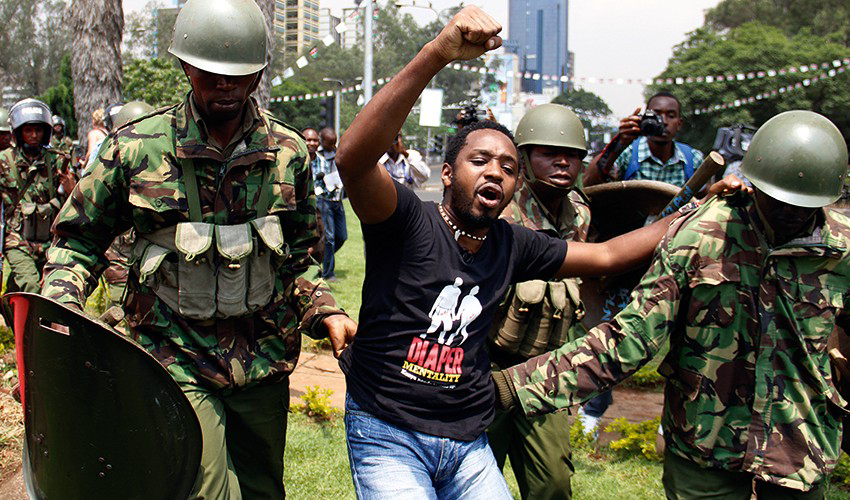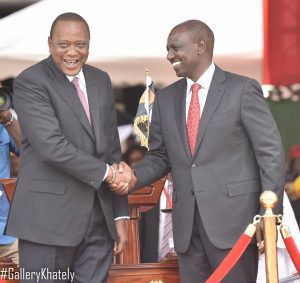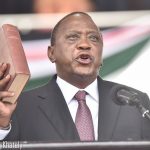New African – Kenya’s Rising Firebrand
By David Meffe
His name is becoming synonymous with the in-your-face fearless type of political and civic activism that always rubs up political elites the wrong way. David Meffe met Boniface Mwangi to find out why he has become one of the most polarising public figures in Kenya’s political counter-culture.
One of the most invincible, indomitable and unassailable men in Kenya, is how one of Boniface Mwangi’s 162,000 Twitter followers described him in a recent tweet, in response to yet another threat of arrest received by this young, rising political firebrand. And what a firebrand he is. Few hold a candle to Mwangi as a critically engaged social and political activist.
With a blend of art, youthful energy and critical expression, he has created a socio-political activism that not only communicates his trenchant critique of Kenya’s political class, but has also brought it global attention.
As a young activist, he has helped the country’s youth not only listen to, see and read his political and social activism, but find their voices of dissent, too.
Mwangi made his start as a photographer with the Standard newspaper in Nairobi and rose to international fame during the 2007-2008 Kenyan post-election violence for his up-close and personal photos of the crisis.
His images were noteworthy for their graphic portrayals of bloodshed and politically-motivated ethnic violence.
In addition to the 2008 and 2010 CNN Africa Photojournalist of the Year awards, the walls of his office are lined with details of other honours and news articles about his accomplishments during this period.
After grappling with depression and feelings of helplessness following the political violence in Kenya, he decided to take his frustration at the stagnant political status quo and point it in the right direction.
“I’m a human being, I have a right to an opinion. They need to respect that,” he says. “That’s the world we want to live in. And never underestimate the government – people can be intimidated into silence.”
His most recent run-in with the authorities was in January during the Occupy Playground protests at the Lang’ata Road Primary School in Nairobi, the Kenyan capital.
The school’s students, aged between 8 and 16, were campaigning against a property developer’s land grab of their playground. Riot police were called to the school and fired tear gas at the pupils.
The scenes of armed riot police, with tear gas and police dogs, scuffling with the pupils, were splashed all over the world and social media, to the disgust of many. Mwangi would later write in the UK’s Guardian online: “The use of tear gas and dogs to respond to a peaceful effort to reclaim property rightfully belonging to the school was an unfortunate blight on the triumph of the day.
“It was unnecessary, and innocent children were hurt by the security forces’ reckless response. Children know an injustice when they see one and they react, as we all do, with a demand for justice. I firmly believe the children got that justice.”
His political views are keenly followed both by supporters and critics alike. In a recent post on his popular Facebook page he wrote: “Kenya is 51 years old and [for] 27 of those we have had 3 Kikuyu presidents. The other 24 years we had a Kalenjin president. In 2017, vote for development not tribe. Tribalism will destroy us.”
Mwangi began organizing political resistance under the banner Kenya ni Kwetu (Kenya is our Home) in the face of what he saw as “irresponsible leadership and a culture of impunity”.
He is also the founder or Picha Mtaani, a youth-led peace initiative which enables young people to become agents of peace and reconciliation in their respective communities.
In 2011, he founded an organization that would become a striking match for underground creative talent in Nairobi. With the help of a few grants and the sale of his personal photography studio, Mwangi opened PAWA254, a creative hub in the heart of Nairobi that houses an eclectic mix of graffiti artists, photographers, journalists and political activists.
The city’s creative class gravitates around the space, which hosts workshops, poetry slams, film screenings, concerts and weekly events where people can gather, mingle and discuss the country’s future in an open forum.
“Art lives in the hearts of people. It’s in music videos, it’s in photos, it’s everywhere,” he says, noting the lack of artistic cohesion in East Africa. “I wanted to bring art to the streets. I wanted to take spoken word poetry into the streets, graffiti, music, and photography. We would use these tools to speak to people in a common language.”
In 2012, Mwangi devised a campaign to stir the pot of political apathy in Kenya by working with local graffiti artists to create street murals decrying violent tribalism and governmental negligence. Working under the cover of darkness, the murals would satirise Kenyan politicians and prominently feature words like greedy, selfish, ineffective and power-hungry.
“Graffiti is an art, and it’s an art that should be respected,” Mwangi says. “So we took something that was once considered only vandalism and made it mainstream. People saw another way of communicating that has never been seen before in Kenya.”
He has also worked with up-and-coming Nairobi bands and performance artists, helping to shape their music with more political undertones.
“We live in a country where musicians don’t speak about social issues. Kenya’s biggest artists will never speak about social change. Why? Because of corporate interests,” he says. “I don’t want my message to be owned by anyone. The day you become big enough to defy social norms, and they still hire you, then you’re setting the standards.”
Mwangi is notorious for bringing artistic imagination and flair to the public protests he has helped organise. One such event featured live pigs covered in blood roaming the streets, while another saw a crowd deliver 49 wooden coffins to the doorsteps of the Kenyan parliament. Mwangi’s public stunts have led to blackmail and even death threats, amid accusations that he is under the patronage and payroll of Western foreign governments or bodies, something he condemns and strongly denies.
Since a big February 2014 protest was shut down before it even began, Mwangi has tried to keep a lower profile, working more behind the scenes with artists and creative Kenyans. Though he is tight-lipped about the future, he says big things are in the works.
“My mother used to tell me that in the 60s and 70s, people would come from all over East Africa to experience Nairobi. It was a safe city then,” he says. “I want them to be able to come back.
“But how do we do that if there are no jobs and the citizens aren’t safe? This needs to be a good place to bring up your child – we change Kenya from the inside, then the whole world
will be able to see who we really are.”
And whether through political theatre, public art, or making creative spaces for others, Mwangi is sure to play a big role in however Kenya changes.
This article first appeared on New Africa’s News and Analysis section




